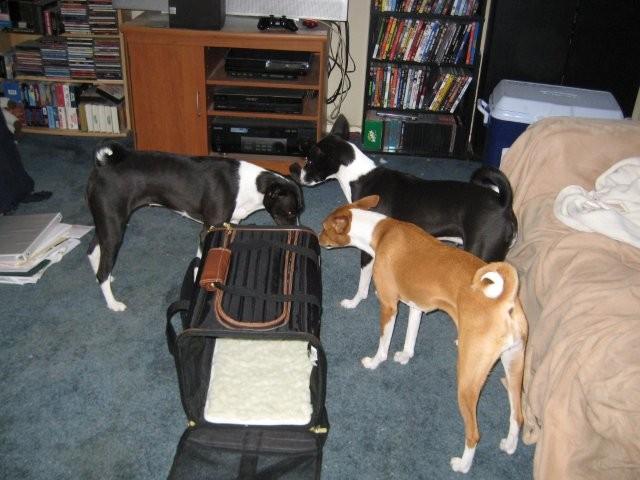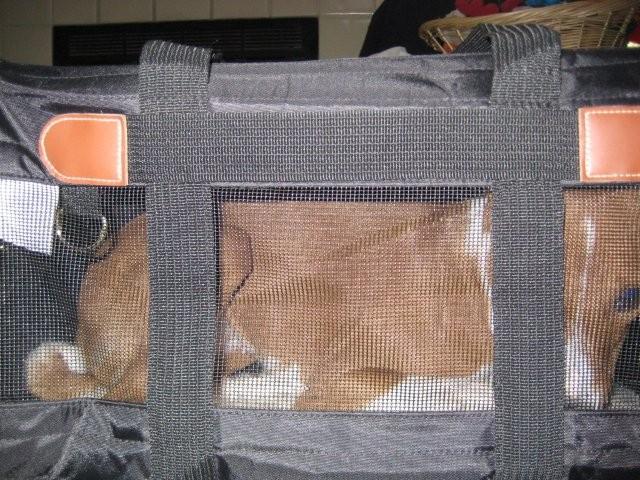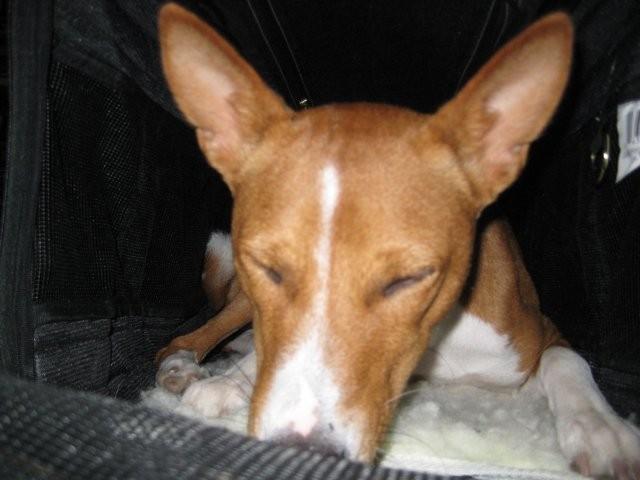My 9 1/2 year old is running Iron Hound this weekend along with another 9 1/2 year old. Both are in good condition and having a blast and are definately still competitive against the youngsters.
lvoss
Posts
-
Life Expectancy?? -
Trail dogI am getting this response in other forums also. It is certain dogs in the breed that do this. Some are easier to train than others. One said he trained his dog not to climb the fence, and I am waiting for a reply as to how he did that. Does anyone here know how to train them not to climb a fence? One said that hers didn't respond well to corrections, but more treat training. My Dobe just likes to please, and will work for treats, except when we play ball, and then its down to business. The beagle looks at you like, so, what's in it for me. You show him the treat, and he's the brightest student in class. So these are the extremes I'm living with. Where in between does the basenji fit??
The basenji is closer to beagle if not a bit more challenging. My obedience instructor said if she had to try to explain a basenji the best way she could think of was to put them in contrast to her whippet. Her whippet is also a sighthound and has a good prey drive but her whippet needs a maid and knows it, he needs some one to open the door, to feed him, to put his coat on him when he is cold. In contrast, a basenji knows there is no maid and even if there was one, isn't sitting around waiting for them to do what needs to be done. Basenjis are intelligent and persistent. They are not going to wait for someone else to solve their problems and often times people are not really pleased with their solutions.
So basenjis do very well with positive reinforcement training because there is a clear benefit to them in doing it. Basenjis can be reinforced to respect boundaries but if the thing on the other side is more rewarding they will probably go for it. Basenjis like being with their people, they enjoy having a "job" in the family even if the job is couch warmer supreme.
Some examples of what living with a basenji can be like. I had to buy a new refrigerator to keep my male from opening the fridge and helping himself to beef and lamb roasts. He would not open the fridge any other time but would sneak off and help himself everytime we had a roast in the fridge. The first time we didn't catch him until he ingested all 2 pounds of roast. He can also open all of our cabinets and drawers so we had to install child safety locks but he learned how to open some of those so we have to be careful what brand we install. Nicky is also quite capable of jumping up on the counter but does not only because as a youngster he accidently jumped into a cake which resulted in an immediate bath and one other time he jumped into a large bowl that soaking in the sink. He now practices look before you leap but if he can see up there then he will be up there.
My girl Rio will happily be contained by a simple baby gate in the house while I am home but if I leave she will be over it in a heartbeat to be with the other dogs and she has always done this. She also easily leaps out of her x-pen, one person at a lure trial described it as watching me catch popcorn when I opened the lid because she would leap into my arms each time.
-
What does it mean to add genes?Debra, that is not so. I attend many seminars given by well respected geneticists. One that I attended dealt exactly with gene preservation and loss and how much of a contribution a single outcross event would have. The scientific answer is after 5 generations a single outcross event is no longer genetically significant. This of course can be influenced by selection of traits though such as the crossing pointers to dalmations to have non-stoneformers. In 5 generations the dogs are once again dalmations genetically except for the preservation of the selected for trait of non-stone formation. The selective breeding to maintain the non-stone forming trait allows it to be preserved if there is no selection for a trait the genes are likely to be lost over generations.
-
Another tick/flea medicine questionA really common mistake that people make with Frontline that severely cuts down on its effectiveness is that they bathe the dog just prior to applying the product. In order for Frontline to work properly a dog should not be bathed 72 hours prior to application nor 72 hours after application. Frontline depends on the dog's natural skin and coat oils to disperse properly and since bathing carries these away it will great reduce the effectiveness.
We usually apply it in the evening after they are beginning to wind down so that they have a good 10-12 hours of quiet time for the product to absorb before they begin rough housing again.
-
Oldest basenji?The owner of the boy I used for my litter has had dogs of her breeding live to 20 years old. Most of her dogs live between 16-18 years.
-
What does it mean to add genes?Debra, I know the math but I am going to side with the geneticist who has done genetic studies on this issue and shown that after 5 generations the genetic contribution is not significant.
-
Basenjis in Edmonton, AlbertaI have both shipped and travelled to get a pup. The suitability of the pups to my household was never an issue with either. I was very honest and very descriptive about my household and expectations and the breeder who knows the pups the best, did a wonderful job of matching the puppy to my household. Even with people who live nearby and visit frequently, it is the breeder who selects the puppy for the person because they know them best and that behavior that seems "cute" in an hour visit may be the completely unlivable in your household on a daily basis.
Young basenji puppies can ride in a sherpa in the plane with you, they do not have to fly cargo. This is exactly how I brought my girl Rally home with me. She did great and had no ill effects from the trip.
Shipping a dog on the other hand requires it to fly cargo. This can be very stressful for some young puppies and others seem to take it in stride.
My preference is for people to pick up their puppies and fly them back in a sherpa with them.
-
Trail dogI take two of my basenjis for country walks off leash with other friends with dogs. All the dogs mostly stay together and all are rewarded frequently for "checking in" with their owners. I am always prepared to leash mine up and probably do leash mine more often than the people with other dogs. So can basenjis be off leash? Yes, but as an owner you will have to make sure the situations are ones that are safe and understand that if you are where there is a lot of wildlife you will probably have to leash them. I would not recommend a basenji to a person who really wants a dog that is going to be good offleash. Their hard wiring is to give chase and though with training you can raise your value so they are more likely to stay near by or if they give chase that they will not go too far, that hard wiring will always be there. They can be good off leash but it is not something that I would expect.
-
What does it mean to add genes?Debra, I am not talking traits, I am talking about total genetic material. After 5 generations from a single outcross event the result is not distinguishable at a GENETIC MATERIAL level from the original population. I am not talking phenotype here, I am speaking genotype. If you want to think that a 1/32 African has some sort of genetic diversity advantage over a full domestic, fine but that isn't what genetic studies support.
-
We are looking for R/W puppy to join our familyNot to question your ability, but if you can't afford another $300 to get a puppy from a reputable breeder, do you have the means to give the dog the proper care it will need. If I look at what we have spent on the puppy since we got her from our breeder we have probably paid an additional $400 (Vet bills, shots, crate, food, treats, obedience class, sweaters, toys, collars, etc.). Dogs can be an expensive proposition you should really think about the total yearly costs to care for the dog not just the acquisition price. I see the BRAT rescue as a great alternative if you are cash strapped right now.
If told you guys how much we have spent in vet bills for our cats and parrots over the last 26 years, you guys would gasp!! Those $300 ****atoos are now worth a small fortune. If one of our birds becomes ill, an $800 - $1000 vet bill is not uncommon. For the cats, 2 years ago we had an $1100.00 vet bill for radioactive isotope therapy (for the tyroid). So, I concur with MDSPHOTO. I don't think anyone here is being uppity, more likely realistic.
Both of these posts are right on. The initial purchase price is only a small fraction of the cost of an animal.
As for breeder's prices, when you are doing the health testing, providing excellent care for the bitch and her pups, etc, the $700-$1000 price isn't always even covering the costs of the litter. To further reduce the price of puppies would mean either cutting corners or losing even more money which in these economic times many don't have to give.
To summarize the breeder costs given in other threads:
Health testing for 1 parent:
OFA Hip x-rays $75 + $30 OFA fee
OFA Patella Check $10 + $15 OFA fee
OFA Thyroid Panel $81 + $15 OFA fee
Fanconi Marker Test $60
CERF Exam $35 + $8 CERF fee for renewal
Brucellosis Test $65Total for health testing 1 parent = $394
Travel Expenses to get the Bitch to the Stud
At least $300 either in shipping and boarding expenses or in gas and lodging expenses, often times more if shipping.
Stud Fee $750-$1000 (Usually the cost of puppy)
Prenatal care $125 for either ultrasound or x-ray. Some breeders do both in order to confirm pregnancy and then to have a good count of what to expect during whelping.
Post whelping expenses (Assumes an average sized litter of 4)
Dew Claw removal and wellness check for mom and puppies - $90
First Shots + Microchip - $310
CERF Exams - $140
Second Shots - $115
Registration - $140Now most breeders will also send home a puppy kit of some sort and these costs don't factor in the food, bedding, clean up supplies, and extra electricity costs. This estimate also does not include any emergency fees which can quickly escalate the cost.
Total is $2364 - $2614. Which would put a low estimate of cost per puppy at $591 - $653.40.
-
New foster Sophia need some adviceBeing food motivated is a good thing. Rather than just feeding her meals out of bowl, put her to work for her food so you can start communicating to her what you want. If she moves away from you even if it is only a few inches toss her some kibble so she has to move even further away to get it. If she lies down somewhere other than your lap, toss to her kibble. Play Its Yer Choice with her, http://www.youtube.com/watch?v=ipT5k1gaXhc
Try a Stuffed Kong to help keep her occupied when you need to crate her or want her to "Go to Mat". If she unstuffs the Kong too quickly, freeze it for more of a challenge.
Kong Stuffing Recipe
Use a large bowl to mix everything up and stuff as many Kongs as you have.Equal amounts of dry dog food and canned pumpkin
Warm water
1 to 3 spoonfuls of canned dog foodFirst, soak kibble in some warm water to soften up. Then mix in pumpkin and canned dog food it should be very thick. Use a small spoon to stuff the mixture into the big end of a kong. (If you like, you may squeeze the Kong and add a biscuit or baby carrot across the top to create a little more challenge.)
-
Sherpa bag training?For those who have wondered about an adult basenji fitting into at sherpa, I have taken some pics of Rio and her sherpa.
Rio checking out the sherpa with her mom and sister
Rio looking for her "crate" treat
Rio getting in the sherpa
All in and zipped up
Don't wake me, I'm napping
Really, I think I'll just chill awhile in here






-
Cream BasenjisHere are some links to see some of the other colors that were mentioned in that thread and some that were not but do occur. It is too bad the older photos are in black and white so you can't really tell the true color.
Creams and Blue Tris if you scroll down - http://www.newworldbasenjis.net/OldAds.htm
Mahogany Tri - http://www.basenji.org/african/Nyanabie.htm
Blue Fawn - http://www.basenji.org/african/Siri.htm
Capped Tri - http://www.basenji.org/african/P_Lady.htm
Trindle - http://www.ktcampbell.com/taji/tazi.html
Saddle - http://www.basenji.org/african/B_Tena.htm -
Blue tri basenjiThe ones that can be registered to AKC are registered. As i have posted somewhere else on these forums, Sarah inherited the blue basenjis from a friend. When her friend passed away, she got these dogs. The lady's son was a complete jerk and couldnt care less for the dogs. His main priority was to get the house cleaned out and sell it for lots of money. So the AKC part is not her fault.
But breeding them without registration is and is NOT responsible. If they are not registered then they should be spayed/neutered. If the registration cannot be legally transferred to her name then they should be spayed/neutered.
In a recesssion, money is always an issue. Just stating a fact. She actally just got done ordering some more tests for Fanconi for 4 more of the basenjis of hers. She is very careful on which basenjis she buys so she doesnt have to worry about Fanconi. However she tests them when she can just to be on the safe side
If in a recession you can't afford to test then you can't afford to breed. There is no such thing as clear by parentage with a marker test, every dog must be tested not "to be on the safe side" but to actually know its marker status. To breed without that testing is outright irresponsible and no justification for purposely breeding without it is going to change that fact.
How do you feel about this breeder having produced Affected offspring when a test was available to prevent it? She has done exactly that so by your own stated opinion this is a wrong thing and yet you are here defending her.
-
Blue tri basenjiI am sorry but that is NOT the truth. She tested the puppies only after the puppy buyer told her there would be no purchase until the puppies were tested.
-
Blue tri basenjiI am sure she will find a "reasonable excuse" for you to anything you ask her but here are the facts.
1. The only health testing she is doing is Fanconi testing and that is only because the BCOA education is working well and people won't buy puppies from untested parents.
2. She is breeding dogs that do not have valid registration. I am sorry but there is no shortage of registered basenjis in this world that there is any valid reason to breed dogs that aren't registered.
3. She breeds multiple litters and multiple breeds each year often at the same time. There is no way to adequately socialize these puppies let alone pay for the type of care to do it right if she can't even find the money to do health testing on the parents. Vet care isn't cheap.
4. Every time you find a "hole" in her story she conveniently "remembers" a detail that she left out to make the story work.
I don't expect this to convince you because you clearly don't want to believe it but this is NOT a responsible breeder.
-
Itchy ears?If he has only just started itching you may have caught it early. It would be better to have it checked out before starting to put things in his ears that could make the situation worse. Yeast loves damp dark environments.
